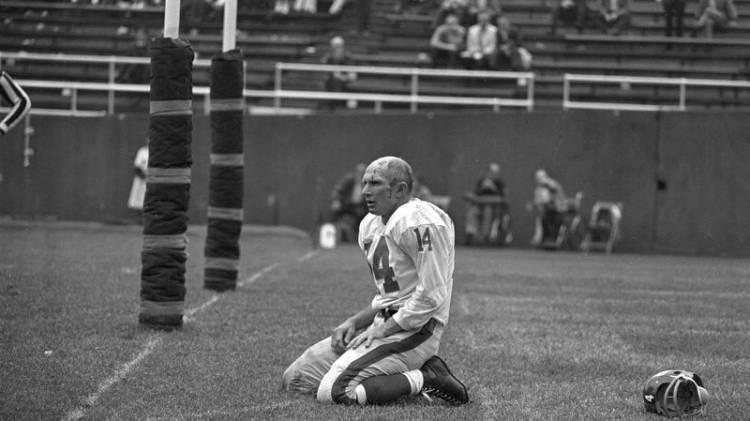
Throughout sports history, there might not be a moment that has perfectly encapsulated defeat and an end of an era as Y.A. Tittle's blood-gushing photo of him sitting in his opposition's endzone with a shattered sternum and concussion. While his fall from grace might have been perfectly captured, Y.A. Tittle's legacy as one of the greatest that still stands even after his recent death in October 2017, at the age of 90. Tittle would go on to play running back, defensive back, and quarterback for Louisiana State University from 1944 to 1947. While a member of the LSU Tigers Tittle would break the standing school records for completions (162), passing yards (2,525), and passing touchdowns (23). Tittle was unable to help his Tiger team solidify an SEC Championship after his pants fell causing him to trip during an interception run back on the final play of the game his senior year.
After becoming renowned for his play at the collegiate level, Tittle was drafted 6th overall in the 1948 NFL Draft by the Detriot Lions. However, despite being drafted by the Lions, Tittle began his pro football career as a member of the Baltimore Colts of the All-America Football Conference (AAFC). After being voted the AAFC Rookie of the Year and playing two seasons with the Colts, Tittle was drafted by the San Francisco 49ers in the 1951 NFL Draft where he would play ten seasons with the team and become a 4x Pro Bowler and lead the NFL in passing touchdowns in 1955. In 1960, Tittle was traded to the New York Giants when he was considered past his prime but would go on to lead the Giants to three consecutive NFL Championship games from 1961-1963 earning him an additional three Pro Bowl invites. After the 1964 season, Tittle retired but is regarded as one of the most competitive and respected quarterbacks to ever take the field.
Most of your favorite celebrities either studied acting in college or went straight from high school into a life of the arts. But, hey, not all of them. Some celebrities actually have advanced college degrees.
Turns out Mayim Bialik is just as much of a genius as the one she plays on The Big Bang Theory. She earned her Ph.D. in neuroscience from the University of California, Los Angeles, focusing on obsessive compulsive disorder among people with Prader-Willi syndrome, a rare condition in which the hypothalamus malfunctions.
Little known fact: Natalie Portman skipped the premiere of Star Wars: Phantom Menace because she was studying for her high school exams. She had two papers published in scientific journals while she was still in high school, and graduated from Harvard University with a B.A. in Psychology.
Before he was looking for answers on X-Files, David Duchovny was just trying to find the answers for English finals at Princeton University90. David graduated from Princeton in 1982 with a B.A in English. He continued to feed his love of literature by receiving a master’s degree in English Literature at Yale University. David was an excellent writer and poet. His work consistently received praise by his fellow classmates and teachers at Yale. His writing was even nominated for a college prize by the Academy of American Poets.
Sigourney Weaver graduated from Stanford University in 1971 with a bachelor’s in Literature. It was while studying at Stanford that Sigourney realized her true passion in life was to become an actress. Shortly after graduation, she attended Yale for their well-known drama program. She would go on to receive a master’s in Acting from Yale University and become friends with fellow famous actress Meryl Streep.
Meryl Streep is considered one of the most successful actresses of all time. She is also one of the most highly educated. Before collecting an array of Oscars, Meryl collected diplomas. She graduated from Vassar College with a B.A. in 1971. Meryl has a habit of being unsatisfied with impressive accomplishments as her acting career has shown, so she attended Yale University and earned a master’s degree in Acting.